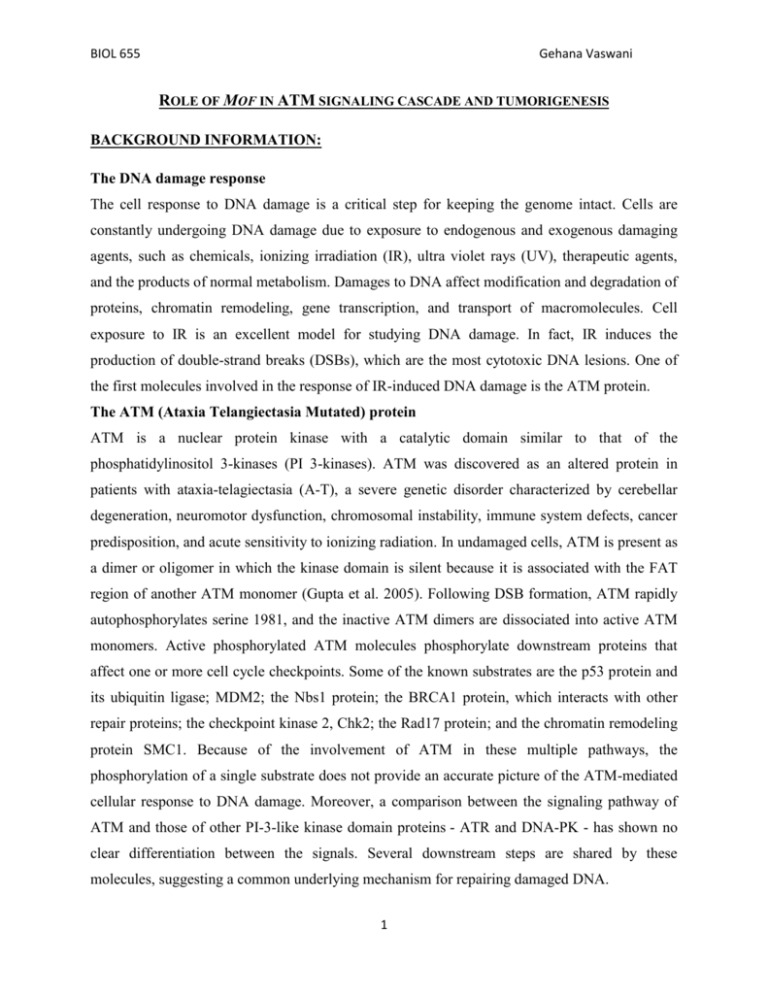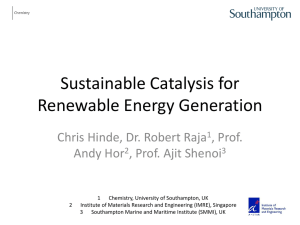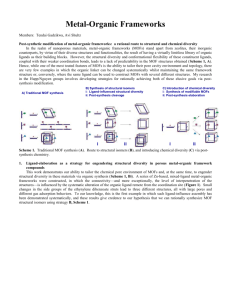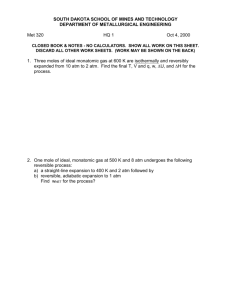Sample proposal
advertisement

BIOL 655 Gehana Vaswani ROLE OF MOF IN ATM SIGNALING CASCADE AND TUMORIGENESIS BACKGROUND INFORMATION: The DNA damage response The cell response to DNA damage is a critical step for keeping the genome intact. Cells are constantly undergoing DNA damage due to exposure to endogenous and exogenous damaging agents, such as chemicals, ionizing irradiation (IR), ultra violet rays (UV), therapeutic agents, and the products of normal metabolism. Damages to DNA affect modification and degradation of proteins, chromatin remodeling, gene transcription, and transport of macromolecules. Cell exposure to IR is an excellent model for studying DNA damage. In fact, IR induces the production of double-strand breaks (DSBs), which are the most cytotoxic DNA lesions. One of the first molecules involved in the response of IR-induced DNA damage is the ATM protein. The ATM (Ataxia Telangiectasia Mutated) protein ATM is a nuclear protein kinase with a catalytic domain similar to that of the phosphatidylinositol 3-kinases (PI 3-kinases). ATM was discovered as an altered protein in patients with ataxia-telagiectasia (A-T), a severe genetic disorder characterized by cerebellar degeneration, neuromotor dysfunction, chromosomal instability, immune system defects, cancer predisposition, and acute sensitivity to ionizing radiation. In undamaged cells, ATM is present as a dimer or oligomer in which the kinase domain is silent because it is associated with the FAT region of another ATM monomer (Gupta et al. 2005). Following DSB formation, ATM rapidly autophosphorylates serine 1981, and the inactive ATM dimers are dissociated into active ATM monomers. Active phosphorylated ATM molecules phosphorylate downstream proteins that affect one or more cell cycle checkpoints. Some of the known substrates are the p53 protein and its ubiquitin ligase; MDM2; the Nbs1 protein; the BRCA1 protein, which interacts with other repair proteins; the checkpoint kinase 2, Chk2; the Rad17 protein; and the chromatin remodeling protein SMC1. Because of the involvement of ATM in these multiple pathways, the phosphorylation of a single substrate does not provide an accurate picture of the ATM-mediated cellular response to DNA damage. Moreover, a comparison between the signaling pathway of ATM and those of other PI-3-like kinase domain proteins - ATR and DNA-PK - has shown no clear differentiation between the signals. Several downstream steps are shared by these molecules, suggesting a common underlying mechanism for repairing damaged DNA. 1 BIOL 655 Gehana Vaswani Several mechanisms have been proposed for the activation of ATM by DNA damage: a) direct activation through interaction with damaged DNA, b) indirect activation through interaction with DNA repair or maintenance proteins, or c) a combination of both. Existing experimental data support the idea that they are activated both through interactions with DNA and members of the repair complexes (Hwang et al. 2002). For example, pre-treatment of DNA-cellulose matrix with IR or restriction enzymes stimulates ATM binding, suggesting that ATM binds to DNA ends. In addition, ATM is part of a super protein complex called the BRCA1-associated genome surveillance complex (BASC), which is involved in the recognition and repair of aberrant DNA structures. It has been found this complex contains several other proteins such as breast cancer gene 1 (BRCA1), mismatch-repair protein hRad50, and BLM helicase (Hwang et al. 2002). ATM also binds to histone deacetylase HDAC1 both in vitro and in vivo, and the extent of this association was increased after exposure of MRC5CV1 human fibroblasts to IR. All these data support the model that multiple protein complexes localize at the sites of DNA damage and interact to trigger the checkpoint-signaling cascade. Males absent on the first (Mof) Histone modifications such as acetylation, methylation and phosphorylation have been implicated in fundamental cellular processes such as epigenetic regulation of gene expression, organization of chromatin structure, chromosome segregation, DNA replication and DNA repair. Males absent on the first (MOF) is responsible for acetylating histone H4 at lysine 16 (H4K16) and is a key component of the MSL complex required for dosage compensation in Drosophila. The human ortholog of MOF (hMOF) has the same substrate specificity and recent purification of the human and Drosophila MOF complexes showed that these complexes were also highly conserved through evolution (Rea et al. 2007). Several studies have shown that loss of hMOF in mammalian cells leads to a number of different phenotypes; a G2/M cell cycle arrest, nuclear morphological defects, spontaneous chromosomal aberrations, reduced transcription of certain genes and an impaired DNA repair response upon ionizing irradiation (Gupta et al. 2005; Rea et al. 2007). 2 BIOL 655 Gehana Vaswani The potential roles of the human ortholog of MOF (hMOF) in the cell (Gupta et al. 2008). Acetylation of histone H4 at K16 by hMOF could: (A) Facilitate a decrease in either the affinity of histones for DNA or in inter-nucleosomal interactions thus opening up the chromatin structure. (B) Act as a binding site for specific proteins that can further modify chromatin, such as transcriptional coactivators or DNA repair proteins. (C) Inhibit binding of specific factors such as transcriptional repressive complexes. (D) Could result in the modification of a protein(s) important for nuclear stability. This target could be either nuclear pore or nuclear membrane associated proteins. Following DNA damage, hMOF may activate ATM (E) Impact one of the cell's main repair pathways. The mechanism for this activation is unknown but may involve increased acetylation around the sites of damage and/or acetylation of other substrates. The tumor suppressor p53 is acetylated by hMOF (F) Result in a decision for programmed cell death as opposed to cell cycle arrest. Moreover, hMOF is involved in ATM activation in response to DNA damage, and acetylation of p53 by hMOF influences the cell's decision to undergo apoptosis instead of a cell cycle arrest. 3 BIOL 655 Gehana Vaswani PROPOSAL QUESTION/HYPOTHESIS: “Mof is essential in ATM-associated DNA Damage Repair but its overexpression leads to tumorigenesis.” Specific Aims: 1. Investigation of proteins involved in ATM activation signaling cascade 2. Role of MOF in tumor cell growth and tumorigenesis EXPERIMENTAL APPROACH AND EXPECTED RESULTS: Methods used for the two proposed experiments: Creating Mof overexpressed cells: Plasmid construction: Plasmids for transfection will be constructed in a pIND (Invitrogen) backbone using pBFT4 as an intermediate cloning vector. Complementary DNA for mouse Mof, which has the same amino acid sequence as human Mof will be generated by polymerase chain reaction (PCR). The resulting product will be incorporated into the vector adjacent to a strong promoter for Mof, and transfected cells will be selected on Kanamycin plates. Generation of stable transfected cell lines: Breast Cancer cell lines (MCF-7 ) (Invitrogen) will be transfected using DMRIE-C (Life Technologies) following manufacturer's instructions in the presence of Neomycin. Creating Mof knockouts: RNA Interference Breast cancer cell lines (MCF-7) will be transfected with Mof shRNA plasmids using Lipofectamine 2000 (Invitrogen) according to the manufacturer’s instructions. 4 BIOL 655 Gehana Vaswani PROPOSED EXPERIMENTS: PART I Proposed experiments to establish the link between Mof and proteins involved in ATM activation signaling cascade To investigate proteins that link Mof and ATM activation, cells that overexpress Mof and Mof knockout cells will be created and subjected to IR radiation. Two-dimensional polyacrylamide gel electrophoresis can be used to purify and characterize the expressed proteins in both cell types. As we want to find the link of Mof with the ATM pathway, we will focus on the presence or absence of ATM downstream and upstream effectors such as Chk, BRCA 2 and other known molecules (Ref. 6: List of known proteins in the Mof complex). We will check for their expression in the presence and absence of Mof. Once protein spots of interest have been revealed from the quantitative analysis of the 2-D PAGE patterns, the problem of identification will be resolved by immunoblotting and peptidemass fingerprinting. Then we can find compare the spots to 2-D PAGE databases, there are a number of protein spots that are already "identified" in a few cell lines. Combined with the aims of the experiment, these databases may give one the opportunity to guess at the identity of a particular protein spot and confirm or deny this by immunoblotting. The approach of obtaining accurate peptide masses from specifically cleaved proteins to search protein sequence databases, known as peptide mass fingerprinting, provides one with another opportunity to identify a previously sequenced protein or (hopefully) confirm that it is indeed novel. Possible outcomes: We will identify how Mof impacts the changes in expression of proteins involved in the ATM pathway following irradiation. The results should enable us to propose a pathway through which DNA repair takes place after activation of ATM in the presence of Mof. In the absence of Mof, we predict that the ATM cascade would not be activated 5 BIOL 655 Gehana Vaswani PART II Literature studies show that, the overexpression of wild-type hMOF yields a modest increase in cell survival and enhanced DNA repair after IR exposure (Rea et al. 2007). These results suggest that hMOF influences the function of ATM. Also, since overexpression of Mof helps cells to avoid apoptosis, Mof may be involved in tumorigenesis. Proposed experiments to examine the role of Mof in tumorigenesis: To study the role of Mof in tumor formation, we will inject breast cancer cell lines (MCF-7), which overexpress Mof or do not express Mof (knockout cells) into the mammary glands of female CD1-NU immunodeficient (nude) mice to observe tumor growth. Before the injection of the cells, a pellet of 17 -estradiol (0.72 mg/pellet, 60 days release time) will be implanted under the skin in the back of the mice. Treatment with tamoxifen will be applied by replacing the estrogen pellet with a tamoxifen pellet (5 mg/pellet, 21 days release time). The tumors will then be investigated 4-6 wk after cell implantation. Cell growth assay of MCF-7, MCF-7 with overexpressed Mof and Mof knockout MCF-7 cells. All cell types will be exposed to DNA damaging agent such as IR (ionizing radiation), and then plated in a tissue culture vessel and allowed to grow. We would predict that the cells with Mof survive as ATM would be active in them and the repair pathway would be active. But, the Mof knockout cells would die. Anchorage-independent growth Assays for anchorage-independent growth will be performed for all three types of cells to check the tumorigenic potential of cells. Each experiment will be repeated independently three times in duplicate, and the results will be expressed as the means of the three experiments. Possible outcomes: 6 BIOL 655 Gehana Vaswani In case of role of Mof in tumorigenesis, we predict more tumor growth in Mof overexpressed cell lines compared to breast cancer cells. Minimal or no tumor growth is expected in Mof knockout cells. CONCLUSION: These in vitro studies will determine ATM dependent and Mof functions in response to IR. We would also be able to find the functional links among Mof, H4-K16 acetylation and IR induced tumor formation. MOF deficiency is involved in genomic instability and defective DNA damage repair. By this experiment, we will whether increased amounts of Mof expression result in cells that proliferate faster and show telltale signs of cancerous transformation. When we inject the same cells into mice, tumors from cells that have an overabundance of Mof are predicted to grow faster than other tumor cells. If we knockout Mof in tumor cells, we predict that they will be weakened and unable to recover after radiation exposure. References: 1) Gupta, T., G. Guerin-Peyrou, et al. 2008. The mammalian ortholog of Drosophila MOF that acetylates histone H4 lysine 16 is essential for embryogenesis and oncogenesis. Mol. Cell. Biol., 28: 397 - 409. 2) Hwang K.K. and H. J. Worman. 2002. Gene regulation by human orthologs of Drosophila heterochromatin protein 1. Biochemical and Biophysical Research Communications 293(4):1217-1222, DOI: 10.1016/S0006-291X(02)00377-7. 3) Sharma G.G., K.K. Hwang, et al. 2003. Human Heterochromatin Protein 1 Isoforms HP1Hs and HP1Hsß Interfere with hTERT-Telomere Interactions and Correlate with Changes in Cell Growth and Response to Ionizing Radiation. Molecular and Cellular Biology, 23(22):8363-8376, DOI: 10.1128/MCB.23.22.8363-8376.2003. 4) Thomas T, Loveland KL, Voss AK. 2007. The genes coding for the MYST family histone acetyltransferases, Tip60 and Mof, are expressed at high levels during sperm development. Gene Expression Patterns 7(6):657-65. Epub 2007 Mar 31. 5) Gupta, A, G. G. Sharma, C.S.H. Young, M. Agarwal, E.R. Smith, T.T. Paul, J.C. Lucchesi, K.K. Khanna, T. Ludwig, T.J. Pandita. 2005. Involvement of human MOF in ATM function. Mol Cell Biol. 25(12):5292-305. 6) Rea S., G Xouri and A Akhtar. 2007. Males absent on the first (MOF): from flies to humans. Oncogene 26: 5385–5394; doi:10.1038/sj.onc.1210607 7 BIOL 655 Gehana Vaswani Reference Table: List of proteins that have been identified in hMOF-containing complexes (6). Name Full name Method for interaction Domains References hMSL1* Male-specific lethal-1 Coiled coil, PEHE domain Affinity purification, Co-IP (Smith et al., 2005; Mendjan et al., 2006) hMSL2* Male-specific lethal-2 RING finger, PHD finger Affinity purification, Co-IP (Smith et al., 2005; Mendjan et al., 2006) hMSL3a/MSL3L1* hMSL3c/MSL3L1c Male-specific lethal-3 Chromobarrel, MRG homology shorter version lacking the chromobarrel Affinity purification, Co-IP, GST-pull down (Smith et al., 2005; Taipale et al., 2005; Mendjan et al., 2006) MRG15 MORF-related gene on chromosome 15 Chromodomain, MRG domain Co-IP (Pardo et al., 2002) (Smith et al., 2005; Mendjan et al., 2006) NSL1/hMSL1v1*(KIAA1267/LOC284058) Non-specific lethal-1 Coiled coil, PEHE domain Affinity purification, Co-IP NSL2* (FLJ20436) Non-specific lethal-2 Two domains rich in cysteine and histidine Affinity purification, Co-IP (Mendjan et al., 2006) NSL3* (FLJ10081) Non-specific lethal-3 Affinity purification, Co-IP (Mendjan et al., 2006) Affinit purification, Co-IP (Dou et al., 2005; Mendjan et al., 2006) / -hydrolase fold HCF-1 Host cell factor 1 Six kelch repeats – domains, Fn3 OGT O-linked -Nacetylglucosaminetransferase TPR, glycosyltransferase Affinity purification (Mendjan et al., 2006) WDR5 or BIG-3* WD repeat domain 5 Seven WD40 repeats Affinity purification (Dou et al., 2005; Mendjan et al., 2006) TPR* Translocated promoter region Coiled coil Affinity purification (Mendjan et al., 2006) MCRS2/p78* Microspherule protein 2 Forkhead associated domain (FHA) Affinity purification (Dou et al., 2005; Mendjan et al., 2006) PHF20* PHD finger protein 20 2 Tudor domain, PHD finger, C2H2 – type zinc finger Affinity purification (Dou et al., 2005; Mendjan et al., 2006) PHF20L1* PHD finger protein 20 like 1 2 Tandem Tudor domain Affinity purification (Mendjan et al., 2006) ILF1/FOXK2 Interleukin enhancer binding factor 1 Fork head DNA binding domain Affinity purification (Mendjan et al., 2006) MLL1 Mixed-lineage leukemia PHD finger and bromodomain Affinity purification, Co-IP, GST-pull down (Dou et al., 2005) ATM Ataxia telangiectasia mutated FAT, FATC, PI3Kc Two-hybrid, Co-IP, GST-pull down (Gupta et al., 2005) p53 TAD, DBD, OD and a proline rich domain GST-pull down (Dou et al., 2005; Sykes et al., 2006) p53 8 propeller









